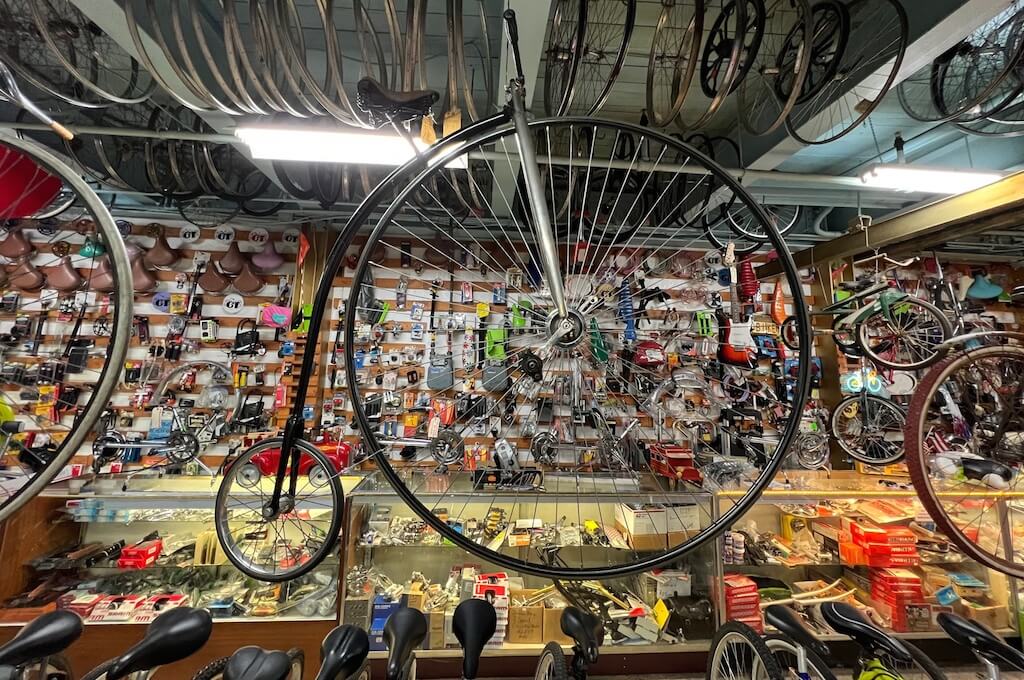Autumn Gear Guide
Find inspiration in our Gear Guide that will keep you out on your bike through wind or rain.
Download NowWhat do 4,000 bicycles actually look like? Once you’ve stood them up, hung them from walls, and color-coordinated their frames, can anyone really grasp such a huge number of bikes? After you remove the pedals and twist the handlebars so that visitors can safely browse, 4,000 bicycles start to blend together. They can barely be […]
What do 4,000 bicycles actually look like? Once you’ve stood them up, hung them from walls, and color-coordinated their frames, can anyone really grasp such a huge number of bikes? After you remove the pedals and twist the handlebars so that visitors can safely browse, 4,000 bicycles start to blend together. They can barely be seen as individual makes and models. They are only tubes and tires, neatly ranked, as far as the eye can see. And it’s divine.

That’s what I found at Bicycle Heaven, the emporium-scale museum in the western corner of Pittsburgh, Pennsylvania. The institution is both a museum and bike shop, contained in a two-story warehouse. Used bikes are arranged in the parking lot out front, all available for purchase, and a neighborly mural is sprawled across the brick facade. Before you even enter the building, you can sense the enormity of its collection.
What follows is a maze of vintage bicycles, parts, and miscellanea, with narrow aisles in between. There are hybrids and racers, BMX bikes, and high-wheelers, lined up as tightly as books on a shelf. Entire walls are packed with drop-barred Schwinns, the kinds of skinny road bikes my parents used to cruise around on in the 1970s. One narrow corridor is covered in dismembered forks, which are arranged into a rainbow of original paint jobs.
Bicycle Heaven was founded in 2011 by local bike mechanic Craig Morrow. What began as a single bicycle pulled out of the trash has ballooned into a vibrant nonprofit organization that repairs and rents bikes and is open seven days a week. To outsiders, Pittsburgh may seem like an odd location for a bicycle museum, never mind the largest such museum in the world. But if you know the city well — and its long traditions of manufacture and offbeat collections — Bicycle Heaven makes perfect sense.

Most of the bikes are everyday models, which have faded over the decades into historical relics. But Bicycle Heaven also has its celebrities: The Bowden Spacelander was renowned for its futuristic design, and of the 600 units ever manufactured, Bicycle Heaven boasts seventeen. Another prominent display is the bicycle from “Pee-wee’s Big Adventure,” the candy-red contraption that served as the film’s McGuffin.
Unlike a stodgier museum, the Bicycle Heaven exhibits are peppered with novelties, like an interactive sculpture of the Three Stooges, vintage movie posters, and a cardboard cutout of Captain Kangaroo proclaiming, “Schwinn bikes are best.” And yet, despite the industrial space and unwieldy collection, Bicycle Heaven is impeccably well organized. The space could easily devolve into a hoarder’s living room; instead, it feels like an overgrown workshop, where every spoke and spanner has its proper place. There’s no gift shop, but mementos are scattered like Easter Eggs throughout the first floor. I myself stumbled into a fitting souvenir: an old-school bicycle license plate, printed with the name of my home state and the year I was born.
One of the best parts of Bicycle Heaven has less to do with the building than its location: The museum stands in an industrial park, just a few quiet streets from a mixed-use trailhead. This trail is miles long and skirts the North Shore, and it offers one of the most scenic rides in Pittsburgh. On a warm and sunny day, pedaling to Bicycle Heaven is the most pleasant way to get there, vastly better than a car or bus. Yes, a highway to Heaven exists, but true salvation will be found on two wheels.
Find inspiration in our Gear Guide that will keep you out on your bike through wind or rain.
Download Now
Leave a comment